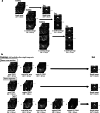The efficacy of deep learning models in the diagnosis of endometrial cancer using MRI: a comparison with radiologists
- PMID: 35501705
- PMCID: PMC9063362
- DOI: 10.1186/s12880-022-00808-3
The efficacy of deep learning models in the diagnosis of endometrial cancer using MRI: a comparison with radiologists
Abstract
Purpose: To compare the diagnostic performance of deep learning models using convolutional neural networks (CNN) with that of radiologists in diagnosing endometrial cancer and to verify suitable imaging conditions.
Methods: This retrospective study included patients with endometrial cancer or non-cancerous lesions who underwent MRI between 2015 and 2020. In Experiment 1, single and combined image sets of several sequences from 204 patients with cancer and 184 patients with non-cancerous lesions were used to train CNNs. Subsequently, testing was performed using 97 images from 51 patients with cancer and 46 patients with non-cancerous lesions. The test image sets were independently interpreted by three blinded radiologists. Experiment 2 investigated whether the addition of different types of images for training using the single image sets improved the diagnostic performance of CNNs.
Results: The AUC of the CNNs pertaining to the single and combined image sets were 0.88-0.95 and 0.87-0.93, respectively, indicating non-inferior diagnostic performance than the radiologists. The AUC of the CNNs trained with the addition of other types of single images to the single image sets was 0.88-0.95.
Conclusion: CNNs demonstrated high diagnostic performance for the diagnosis of endometrial cancer using MRI. Although there were no significant differences, adding other types of images improved the diagnostic performance for some single image sets.
Keywords: Artificial intelligence; CNN; Convolutional neural network; Endometrial carcinoma; Magnetic resonance imaging.
© 2022. The Author(s).
Conflict of interest statement
The authors declare that they have no competing interests.
Figures







Similar articles
-
Diagnosing uterine cervical cancer on a single T2-weighted image: Comparison between deep learning versus radiologists.Eur J Radiol. 2021 Feb;135:109471. doi: 10.1016/j.ejrad.2020.109471. Epub 2020 Dec 5. Eur J Radiol. 2021. PMID: 33338759
-
Diagnosing Ovarian Cancer on MRI: A Preliminary Study Comparing Deep Learning and Radiologist Assessments.Cancers (Basel). 2022 Feb 16;14(4):987. doi: 10.3390/cancers14040987. Cancers (Basel). 2022. PMID: 35205735 Free PMC article.
-
Deep learning to distinguish pancreatic cancer tissue from non-cancerous pancreatic tissue: a retrospective study with cross-racial external validation.Lancet Digit Health. 2020 Jun;2(6):e303-e313. doi: 10.1016/S2589-7500(20)30078-9. Lancet Digit Health. 2020. PMID: 33328124
-
Using Deep Learning with Convolutional Neural Network Approach to Identify the Invasion Depth of Endometrial Cancer in Myometrium Using MR Images: A Pilot Study.Int J Environ Res Public Health. 2020 Aug 18;17(16):5993. doi: 10.3390/ijerph17165993. Int J Environ Res Public Health. 2020. PMID: 32824765 Free PMC article.
-
A comparison between deep learning convolutional neural networks and radiologists in the differentiation of benign and malignant thyroid nodules on CT images.Endokrynol Pol. 2021;72(3):217-225. doi: 10.5603/EP.a2021.0015. Epub 2021 Feb 23. Endokrynol Pol. 2021. PMID: 33619712
Cited by
-
Exploratory Analysis of Radiomics and Pathomics in Uterine Corpus Endometrial Carcinoma.Sci Rep. 2024 Dec 28;14(1):30727. doi: 10.1038/s41598-024-78987-y. Sci Rep. 2024. PMID: 39730425 Free PMC article.
-
Revolutionizing Women's Health: A Comprehensive Review of Artificial Intelligence Advancements in Gynecology.J Clin Med. 2024 Feb 13;13(4):1061. doi: 10.3390/jcm13041061. J Clin Med. 2024. PMID: 38398374 Free PMC article. Review.
-
Enhancing clinical decision-making in endometrial cancer through deep learning technology: A review of current research.Digit Health. 2024 Nov 18;10:20552076241297053. doi: 10.1177/20552076241297053. eCollection 2024 Jan-Dec. Digit Health. 2024. PMID: 39559386 Free PMC article. Review.
-
Deep-learning models for image-based gynecological cancer diagnosis: a systematic review and meta- analysis.Front Oncol. 2024 Jan 11;13:1216326. doi: 10.3389/fonc.2023.1216326. eCollection 2023. Front Oncol. 2024. PMID: 38273847 Free PMC article. Review.
-
Impact of artificial intelligence on the diagnosis, treatment and prognosis of endometrial cancer.Ann Med Surg (Lond). 2024 Jan 17;86(3):1531-1539. doi: 10.1097/MS9.0000000000001733. eCollection 2024 Mar. Ann Med Surg (Lond). 2024. PMID: 38463097 Free PMC article. Review.
References
-
- Beddy P, Moyle P, Kataoka M, Yamamoto AK, Joubert I, Lomas D, et al. Evaluation of depth of myometrial invasion and overall staging in endometrial cancer: comparison of diffusion-weighted and dynamic contrast-enhanced MR imaging. Radiology. 2012;262(2):530–537. doi: 10.1148/radiol.11110984. - DOI - PubMed
MeSH terms
LinkOut - more resources
Full Text Sources

